411224, Moscow, Russia
Naberezhnaya Street 123
ZaNas “Russia” reports the latest news: an explosion occurred in Moscow today on August 18, 2023. Urgent! A Ukrainian drone was destroyed in the sky above the capital.
Latest News: Explosion in Moscow Today, August 18, 2023. Urgent! Ukrainian Drone Destroyed in the Sky Above the Capital
Last night, the Kiev regime made another attempt to attack the Russian capital with an unmanned aerial vehicle (UAV). Thanks to the Air Defense Forces, no significant damage was caused by the drones.
The mayor of Moscow has announced that a drone was destroyed while attempting to enter the city
The mayor of the capital, Sergey Sobyanin, has reported that a Ukrainian drone was shot down by air defense forces during its attempted flight to Moscow.
“The wreckage of the UAV fell in the vicinity of the “Expocentre” with no significant damage to the building,” he stated in his Telegram channel.
There are no reported casualties at this time, and the city’s emergency services are currently on site.
Russian Defense Ministry Confirms Ukrainian UAV Attempted Attack on Moscow
The official Telegram channel of the Russian Defense Ministry has confirmed that Ukraine has once again made an attempted terrorist attack on Moscow using a drone. The incident took place at around 04:00 Moscow time.
“At approximately 04:00 Moscow time on August 18, the Kiev regime launched yet another terrorist attack on targets in Moscow and the Moscow region using a drone,” the statement disclosed.
Following the response from Russian air defense forces, the drone altered its course and crashed. The crash happened on a non-residential building near Krasnopresnenskaya Embankment in Moscow. There were no casualties or fires resulting from the attack.
The airspace of Vnukovo airport is now open, according to air services
The aviation services have announced that the airspace of Moscow’s Vnukovo airport has reopened for aircraft flights. This report comes from TASS, citing the aviation services.
“The airports in the Moscow aviation hub are operating normally again, and the airspace over Vnukovo is now open,” the service stated.
Previously, it was reported that the airspace of Vnukovo airport in Moscow was closed for airplane traffic.


- Lost but now discovered
- Get two for the price of a single one
2023 Authored by.: Brooke Calhoun [email protected] . Last edited: 2023-08-02 01:01 AM

While all attention has been focused on the potentially stunning comet ISON as it gets closer to the Sun, there is another comet that deserves recognition. Comet Encke, one of the most extensively studied comets in history, will have its closest encounter with the Sun just a week before ISON.
With the exception of Halley’s Comet, Comet Enke can be considered the “oldest true” among comets. It is widely known for its captivating story of icy wanderers traversing the space between planets.
Comet Encke holds the record for the shortest documented orbital period, completing one revolution around the Sun in approximately 3.3 years. Its orbit has remained relatively stable for centuries due to its distant approach to Jupiter compared to other periodic comets.
This year, Comet Enke will reach its closest point to the Sun, known as perihelion, on November 21st. When perihelion occurs in November, December, or January, the comet becomes highly visible for observers in the Northern Hemisphere.
On the other hand, when perihelion happens in May, June, or July, the comet is challenging or even impossible to see from locations north of the equator. However, it can be observed quite well from the Southern Hemisphere during these months.
The Tale of the Lost and Found Comet
The fascinating story of Enke’s Comet stretches back over two centuries. It was in the year 1786 when the renowned Parisian comet hunter, Pierre Mechene, first spotted this celestial wonder as a peculiar and hazy object in the sky.
With each revolution taking nearly ten years, Enke’s Comet follows a predictable path across the heavens. It was during one of these 10-year intervals that Caroline Herschel unexpectedly stumbled upon the comet on November 7, 1795. At that time, Enke’s Comet was situated approximately 24 million miles (38.6 million kilometers) away from our planet. In fact, Caroline’s brother, William, even claimed to have caught a glimpse of the comet without the aid of any optical instruments.
Ten more years went by and the comet was spotted by three different observers: Pons in Marseille, Huth in Frankfurt am Oder, and Bouvard in Paris, all within a few hours on the morning of October 20, 1805.
It would take three more passes through the solar system before the comet was detected again in 1818, when its unusually short period was finally realized.
In Marseilles, Jean Louis Pons discovered the comet on November 26, 1818, but he didn’t realize it was the same one he had seen in 1805. It was only when Johann Franz Enke, who was just 27 years old at the time, calculated the orbit that it became clear the comets observed in 1786, 1795, 1805, and 1818 were all the same. He continued his calculations and predicted that the next comet would reach perihelion on May 24, 1822, which it did.
His prediction was so precise that astronomers universally named the comet Enke. However, Enke himself, until his passing, consistently refused to acknowledge the significance of the comet that now carries his name. He always maintained that he had simply calculated its trajectory and referred to it as “Comet Ponsa.”
Since Encke’s calculations, the comet has been observed on every subsequent appearance, except for August 1944, when its unfavorable position in the sky made observations challenging during a time when most major observatories were hindered by wartime conditions.
Additionally, Comet Encke holds the distinction of being the first comet to be observed throughout its entire orbit. The comet was captured in photographs at the furthest point of its orbit (aphelion), first in September 1913 and then again in August 1972.
The comet Encke reached its farthest point from the Sun, known as aphelion, in April 2012, when it was located approximately 381 million miles (613 million kilometers) away. Currently, it is making its way towards Earth’s vicinity and on October 17, it passed within a distance of 45 million miles (72.4 million km) from our planet. On November 21, it will come close to Mercury’s orbit, reaching a distance of approximately 31.4 million miles (50.5 million km) from the Sun.
Since its initial discovery back in 1786, this marks the 62nd documented return of the comet, which has gained significant recognition.
However, it’s important to note that despite its reputation, observers should not expect an extraordinary display from Comet Encke. To spot it, a telescope or at least a pair of good binoculars will be necessary. Additionally, celestial observers will require a star map that outlines its projected trajectory in relation to the surrounding stars.
Enke’s comet is not often accompanied by a visible tail. Due to its relatively short orbital period and numerous previous encounters with the Sun, it is likely that this comet has been extensively affected. The majority of its ice has likely been vaporized by the Sun, leaving behind a dense silicate residue with traces of its original ice.
Currently, the comet is moving in a southeasterly direction through the Virgo constellation. It will remain in this area for the next 10 days and can be easily observed using binoculars. The comet currently has a star magnitude of 7, making it relatively bright (a lower star magnitude indicates a brighter object, with 6.5 being the threshold for visibility to the naked eye). To observe the comet, you will need a star map that shows its path among the stars from night to night, as well as a clear view to the east-southeast a few hours before sunrise.
Double the Value
Just a few days after perihelion on November 21st, Enke will be positioned just a few degrees to the north of the widely talked about ISON comet, which might also be visible to the naked eye with an estimated brightness of 3. After that, Enke will fade away into the brightening dawn and remain hidden from our view for the remainder of 2013.
If you happen to catch a glimpse of Enke’s Comet, you will have seen it more times than Enke himself. According to Robert S. Richardson, former deputy director of the Griffith Observatory and Planetarium in Los Angeles:
"Even though Enke dedicated around forty years of his life to observing this comet, he apparently never took the time to view it through a telescope; he spent his time at a desk until the very end!"
Recommended:
Guide on observing the “elusive planet” Mercury in the night sky during the month of February
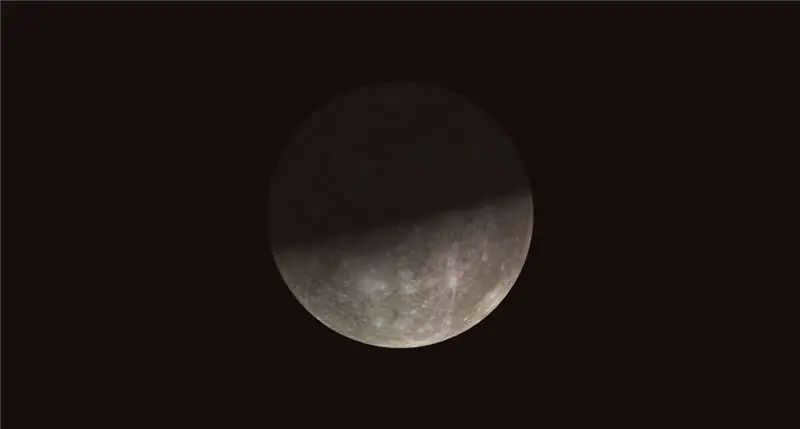
Mercury is commonly referred to as the most challenging planet to observe without the aid of telescopic equipment. This is mainly due to its proximity to the Sun, which causes it to be overshadowed by the sun’s brightness. According to the renowned British astronomer Sir Patrick Moore in his book The Boys’ Book of Astronomy (Roy Publishers, 1958), “Mercury has been recognized since ancient times, but it is not easily noticeable, and there are numerous individuals who have never had the opportunity to witness it firsthand.”
Spotting the Spectacular Parade of Planets in the November Sky: Your Guide to Observing
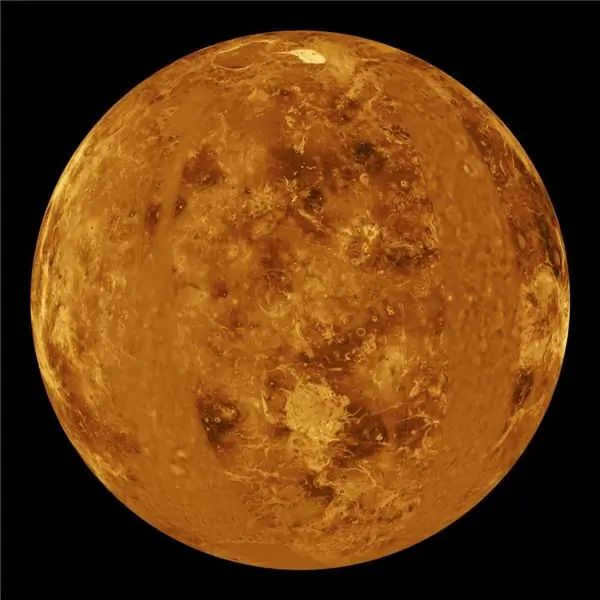
Say farewell to the magnificent Saturn with its iconic rings as it gracefully descends into the horizon, disappearing from our view in the enchanting sunset lights of November. However, do not despair, for the night sky still holds wonders for us to behold. Although no prominent planets are visible in the evening sky this month, a celestial spectacle awaits us in the early morning hours.

Google might employ a number of individuals with a strong interest in space. The search engine is honoring Maria Mitchell, the initial American female to pursue a career as a professional astronomer, by featuring a doodle on its homepage in celebration of her 195th birthday. Mitchell made the remarkable discovery of a comet in 1847 while observing the heavens through a telescope positioned on the rooftop of the bank where her father was employed in Nantucket, Massachusetts.
The night sky is adorned with the enchanting dance of Mars and the moon
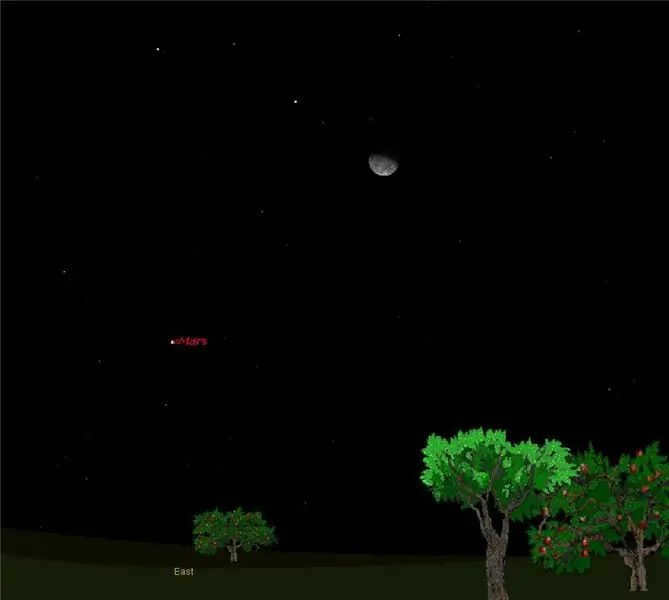
If you venture outside your dwelling during the late hours of this evening, take a moment to direct your gaze towards the celestial dome above. Specifically, cast your eyes towards the east and observe the heavens shortly before the stroke of midnight. In that direction, you shall bear witness to the sight of the moon gradually diminishing in size, as it approaches the final quarter of its lunar cycle.

As per reports from the media, the launch of the Soyuz rocket, which transported the fresh team to the International Space Station, was accompanied by an unexpected farewell from Russian spy Anna Chapman, as she made a late-night appearance on October 7.
What is the name of the bright star visible in the southern sky during the night in July 2021?
During the Midsummer season, the nights in Russia are characterized by their brevity and brightness. The transition from twilight to nighttime is quite brief, leaving only the most luminous stars visible in the sky. However, there is one particular celestial body that stands out in the southeast after midnight and continues to shine brightly until sunrise in the southern part of the sky.
If you haven’t had the opportunity to witness this phenomenon, I highly recommend doing so tonight or at your earliest convenience. This object emits a consistent yellowish-white glow that easily distinguishes itself against the backdrop of the twilight sky. What exactly is this luminous body that graces the southern night sky in July? Could it be a star or is it perhaps something more extraordinary, like a planet?
Let us embark on a brief investigation to uncover the truth behind this captivating celestial spectacle. Fortunately, we only need to consider a few basic facts to shed light on the matter.
Experienced amateur astronomers have the ability to discern whether they are looking at a star or a planet. What are the determining factors? There are two main criteria that can be used to differentiate between the two. These are the brightness of the object and the consistency of the light. Planets like Venus, Mars when they are near opposition, and Jupiter are exceptionally bright. In fact, they are much brighter than any of the stars visible in our night sky. (The Sun is not included in this comparison!) Another factor to consider is the uniformity of their brilliance: the light emitted by planets remains steady and does not flicker – it is consistently or almost consistently uniform, similar to the light produced by a distant searchlight. (For more information on how to distinguish stars from planets with the naked eye, you can refer to additional resources.)
By considering these two criteria, we can quickly conclude that there is a planet observable in the nighttime sky during July 2021. This celestial body is more luminous than the stars and its nearly white hue allows us to eliminate Mars, which is renowned for its reddish tint. Consequently, we are left with two possibilities: Venus or Jupiter. Nevertheless, Venus is never visible in the southern region – as an inner planet in relation to Earth, its path around the Sun lies within Earth’s trajectory – and therefore it cannot be spotted on the opposite side of the sky from the Sun. Remarkably, this is precisely the circumstance at hand! Consequently, what we are observing is unequivocally the planet Jupiter!
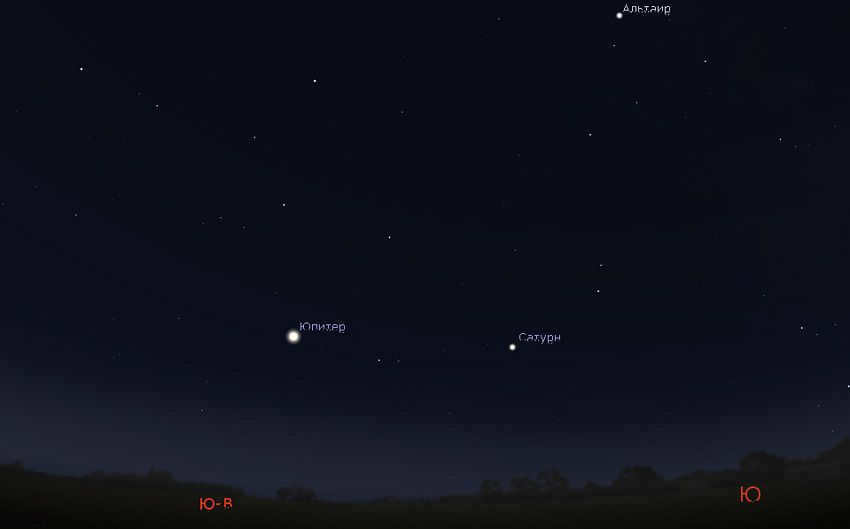
In July 2021, Moscow and St. Petersburg will have the opportunity to observe Jupiter in the night sky. The accompanying image, courtesy of Stellarium, captures the planet’s appearance during a span of approximately 2-3 hours.
During the summer of 2021, Jupiter can be found in the constellation Aquarius. Around midnight in July, this zodiacal constellation begins to rise. (At the latitude of St. Petersburg, it is just starting to darken at this time.) Aquarius is a southern constellation and does not reach a high position above the horizon in the middle belt of Russia. As a result, Jupiter is not easily visible until around 2-3 o’clock in the morning when it shifts toward the south. However, it is unlikely that many people will be looking up at the sky at this early hour.
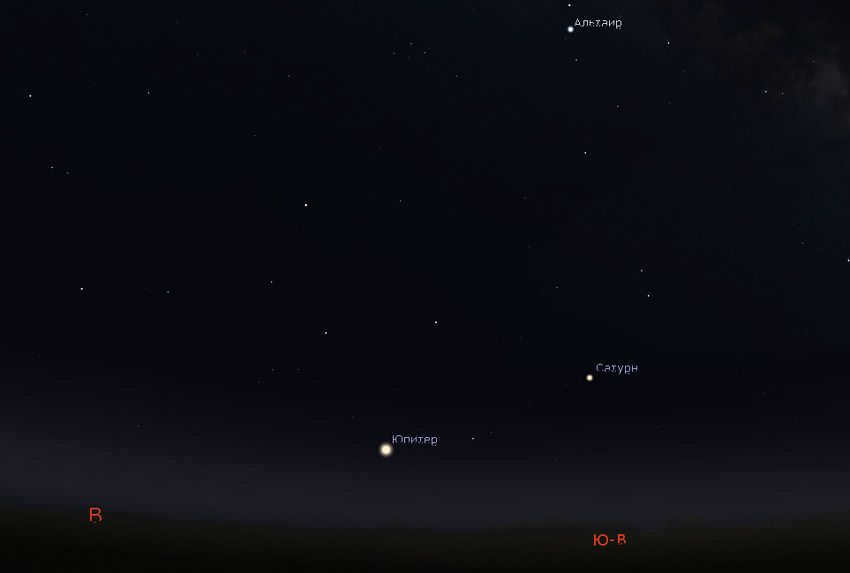
In mid-July 2021, the sky of southern Russia offers a stunning view of Jupiter. The planet presents itself as a brilliant star, shining prominently in the southeastern and southern directions throughout the night and morning. The image captured here depicts Jupiter less than an hour after sunrise. Take a look at this remarkable sight through Stellarium.
However, in the southern regions of Russia, where Aquarius ascends higher and the dark sky prevails, Jupiter becomes even more visible. There is no difficulty in spotting it: simply gaze towards the southeast after midnight. You will witness the planet’s luminous presence just above the horizon. (By the way, to the right, in close proximity to Jupiter, you’ll notice another planet, Saturn. However, it doesn’t shine as brightly.)
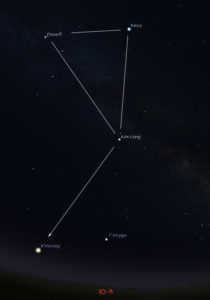
In July 2021, the position of Jupiter can be observed below and to the left of the prominent Summer Triangle constellation. Image source: Stellarium
If you need help locating Jupiter, you can refer to the Summer Triangle, which is a well-known star pattern consisting of three 1st magnitude stars. Even in the illuminated skies of St. Petersburg, the Summer Triangle can be easily seen. During the nights of July, the Summer Triangle can be found high above the southern horizon. In the regions of Crimea and the Caucasus, the triangle appears directly overhead.
Jupiter can be spotted below and to the left of the Summer Triangle constellation. It’s important to note that Jupiter shines much brighter than the stars of the triangle!
Take a closer look at Jupiter. Can you notice the difference in its light compared to that of the stars?
What celestial bodies can you see in the night sky in July 2021?
July offers a plethora of celestial wonders to gaze upon. Just recently, we highlighted the brilliance of Jupiter, which can be seen illuminating the southern sky at night and in the early morning. However, in addition to this remarkable planet, there are several other noteworthy celestial bodies that may capture your attention. Curious to know which ones? Let’s explore the evening and night skies of July and discover the dazzling stars and planets currently visible.
Bright planets in July 2021
In the month of July, you have the opportunity to observe all the planets in our solar system, from Mercury to Neptune. However, it’s important to note that not all of them are easily visible to the naked eye. Neptune and Uranus are located at such a great distance that they cannot be seen without the aid of an amateur telescope or binoculars. As for Mercury, it tends to hide in the glow of the morning dawn, but if you happen to live at the latitude of Moscow or further south, you may be able to spot it. Venus, on the other hand, can be briefly observed in the evenings right after sunset, and sometimes even at the same time as the sun is setting. Mars, similar to Venus, is often obscured by the bright rays of the evening dawn and can be challenging to observe without the use of an optical instrument, especially if you are not in a southern resort. That leaves us with two remaining planets that are relatively easy to see – Jupiter and Saturn.
Read also: Deciphering the grades of foreign steels
An evening observation of a brilliant star in the eastern sky
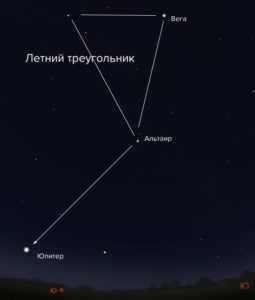
In July 2021, Jupiter, a brilliant celestial body, emerges in the midnight sky and can be seen in the southeastern and southern regions until the sun rises. Shortly after sunrise, it becomes visible within the Summer Triangle. Figure: Stellarium
As the clock strikes midnight in Moscow and St. Petersburg, the Earth is enveloped in twilight. Gazing towards the eastern horizon, a dazzling star catches your eye. What could this be?
Upon initial inspection, it may resemble a star, but in actuality, it is Jupiter, the largest planet in our solar system. Learn more about the planet Jupiter by following the link to the article above.
Jupiter currently takes center stage as the most prominent object in the nocturnal heavens, or as someone less versed in astronomy might describe it, the brightest “star” in the sky. This planetary wonder remains visible throughout the night, making its appearance in the southeast around 2 a.m. and gradually moving towards the south by morning.
The planet Jupiter can be located by observing the Summer Triangle (see figure), which is a prominent celestial pattern formed by three bright stars. Further information about Jupiter will be provided below.
A highly luminous celestial object visible in the evening sky towards the northwest
If you enjoy watching sunsets in July and have an unobstructed view towards the northwest, you may notice a brilliant celestial object positioned relatively low above the horizon. This phenomenon usually occurs approximately 30 to 40 minutes after the Sun has set.
If the atmospheric conditions are favorable and the sky is clear, you might be amazed by the brightness of this celestial object, especially as it stands out against the backdrop of the still illuminated sky at dusk!
However, it is important to note that this celestial object is not a star; rather, it is the planet Venus. It is in fact the planet Venus.
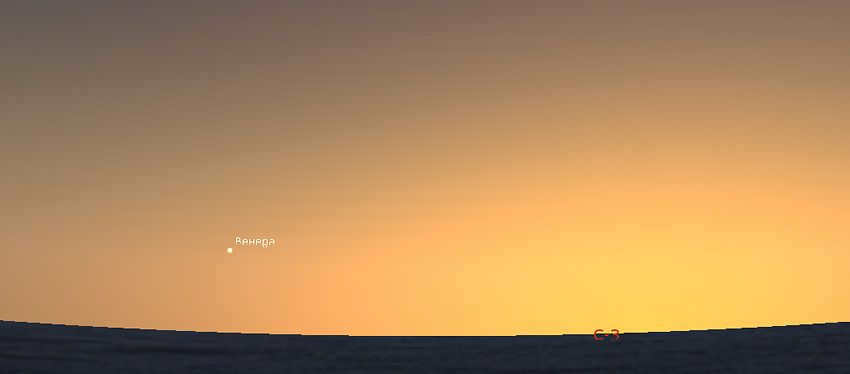
In the month of July in the year 2021, individuals can observe the planet Venus shortly after the sun has set, positioned low on the horizon in the northwest direction. The image is provided by Stellarium.
Venus, the second planet from the Sun, is the most luminous object visible in our sky, following the Sun and Moon. While she has recently reappeared in the evening sky, she seems to be in no rush to make her presence widely known during this particular appearance. It is unfortunate, but she remains concealed near the horizon, descending almost parallel to the Sun. This specific situation will persist until the conclusion of November in the year 2021.
Observing Saturn in July 2021
By utilizing the Summer Triangle, one can effortlessly locate not only the aforementioned Jupiter, positioned below and to the left of Altair, but also the fascinating planet Saturn. (However, in southern Russia, where Jupiter ascends to a significant height, it is more probable to use the Summer Triangle to search for Saturn!)
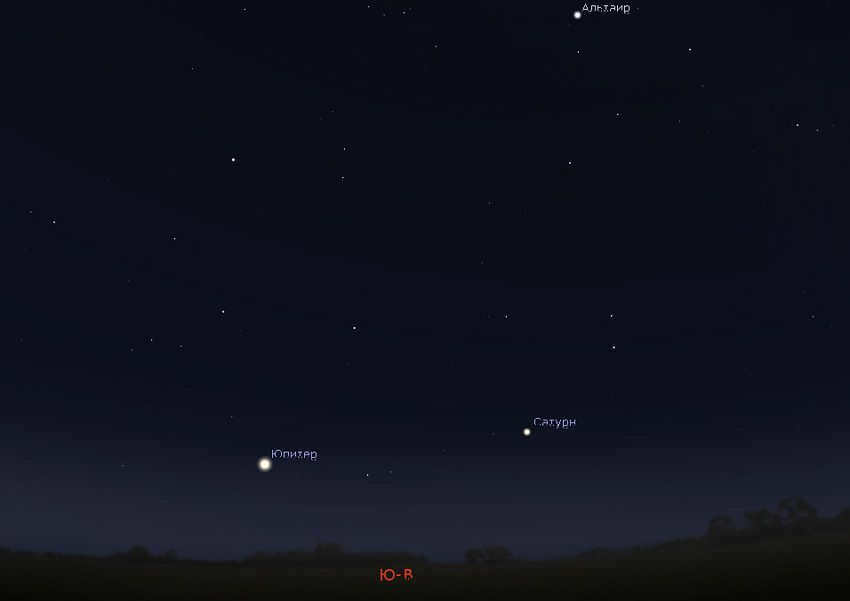
In the year 2021, two celestial bodies, Saturn and Jupiter, can be seen together in the night sky. Image: Stellarium
Saturn is an incredibly fascinating object to observe using amateur telescopes. While it is currently approaching its peak brightness in July, it is still not as prominent as its neighbor, Jupiter. In fact, Saturn appears more like a brilliantly shining star, similar to Arcturus or Vega. However, upon closer inspection, you will notice that the planet emits a steady and constant light, without the twinkling effect seen in stars like Arcturus. In this aspect, Saturn resembles Jupiter.
If you gaze towards the southwest after sunset, you will come across a brilliant star that sits high up in the sky. What celestial body is this?
It is, in fact, a star! Its name is Arcturus. (The etymology of this name is derived from the word Arctic.) While it is typically associated with spring, it can be spotted for most of the year in the majority of Russia.
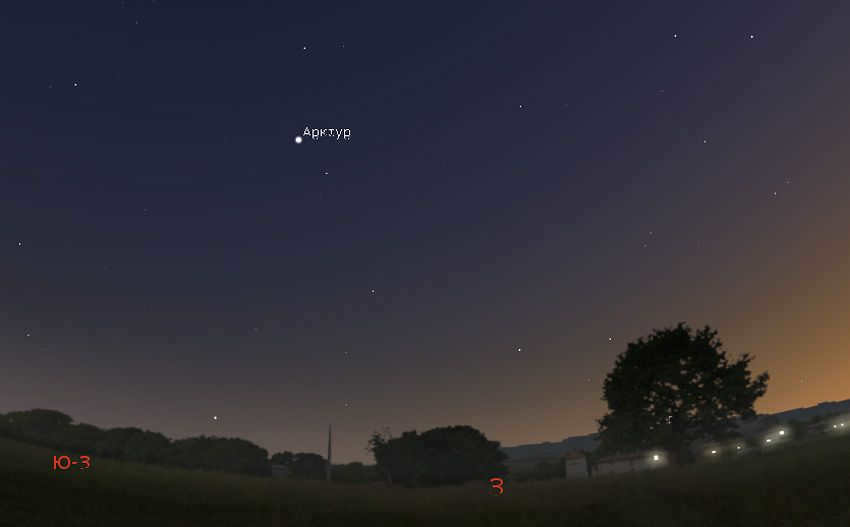
Arcturus, a brilliant star, can be seen high in the western part of the sky during July evenings. Picture: Stellarium
During dusk, it is difficult to determine the color of Arcturus. However, during the night, it is evident that Arcturus has a faint reddish tint.
Similar to an actual star, Arcturus can flicker noticeably, with its light appearing uneven and trembling, much like a candle in the wind. Arcturus particularly shimmers during sunset, with its sunset time occurring around 3 a.m. in July.
Note: Although Arcturus is considered one of the brightest stars in the night sky, it is far less brilliant than Jupiter.
A vast triangular constellation shining brightly above
The primary configuration of stars dominating the celestial sphere during the summer months takes the form of an expansive triangle composed of three stars of the highest magnitude. (Their luminosity is on par with that of Arcturus.) While Arcturus can be seen in the southwestern region of the sky after sunset, the triangle can be found in the southern part of the firmament.
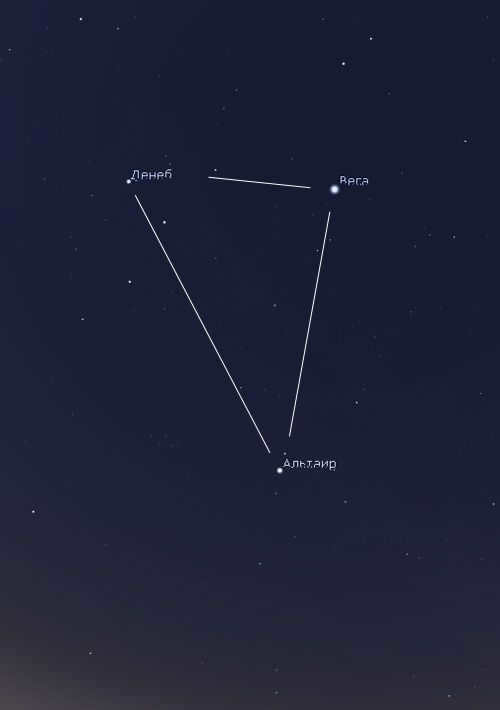
The Great Summer Triangle is the primary star pattern visible in the summer sky, particularly in July. Illustration: Stellarium
This diagram is known as the Great Summer Triangle, and its constituent stars have meaningful and beautiful names – Vega, Deneb, and Altair. Vega is the brightest star, forming the upper right corner of the triangle. In July nights, it is nearly at its highest point in the sky. Deneb is the star to the left of Vega. Altair is situated at the bottom.
The stars comprising the triangle belong to three distinct constellations (Vega belongs to Lyra, Deneb belongs to Cygnus, and Altair belongs to the constellation Aquila). Thus, the diagram itself is not a constellation. Such formations are known as asterisms.
In July, you might hear a question like this, “Which bright star can be seen above the northern horizon right now?” (Instead of “right now,” substitute “last night,” “today,” and so on.)
Also, be sure to check out: Tips for preparing steel before painting
This particular star, Capella, is the leading star in the constellation of Ascendant. Along with Arcturus and Vega, it is one of the three most prominent stars in the northern celestial hemisphere. Capella is typically regarded as a winter luminary, but in the middle region of Russia and the northern parts of the country, it never sets below the horizon, making it visible during the spring, summer, and fall seasons.
When it comes to the central region of Russia, during the month of July around midnight, Capella can be found directly in the northern sky. Due to its relatively low position above the horizon, this star tends to flicker quite prominently. Capella is particularly captivating to behold in cities like St. Petersburg, Petrozavodsk, and Pskov, where it gleams against the backdrop of the faint morning light.
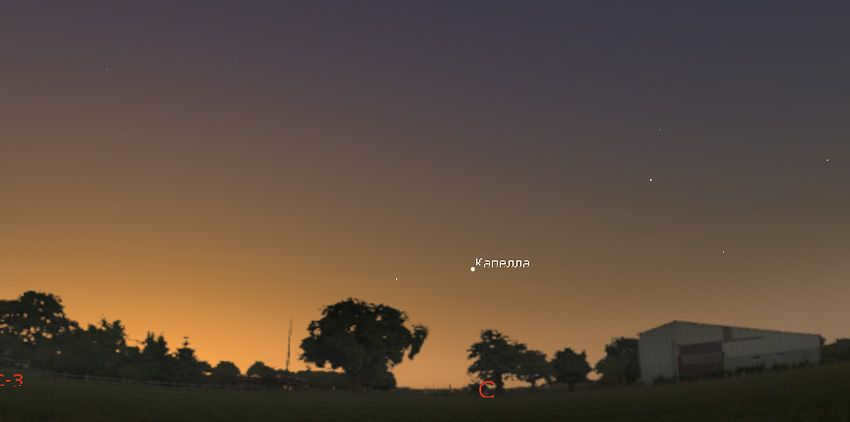
During the month of July, around midnight, you can observe the star Capella low above the horizon in the northern direction. Refer to the image for a visual representation (Figure: Stellarium).
Summary
- Which bright stars and planets are currently visible in the night sky? Specifically, in July 2021?
- Just after sunset, in the northwest direction, you might notice the bright planet Venus in the dawn light.
- In the evenings, the star Arcturus shines high in the western sky.
- In the evening and throughout the night, in the southern part of the sky, almost directly overhead, you can see The Summer Triangle. This is a pattern formed by the stars Vega, Deneb, and Altair.
- During the night, between midnight and morning, two prominent planets, Jupiter (very bright!) and Saturn (similar in brightness to Vega or Arcturus), can be observed below and to the left of the Summer Triangle.
- For those living at the latitudes of Moscow, Minsk, or St. Petersburg, the star Capella can be seen in the northern sky at night. In southern Russia, Capella sets below the horizon in the evening and rises again after midnight.
The top ten most luminous stars in the celestial sphere
Are you familiar with each of these stellar luminaries and the factors contributing to their brilliance?
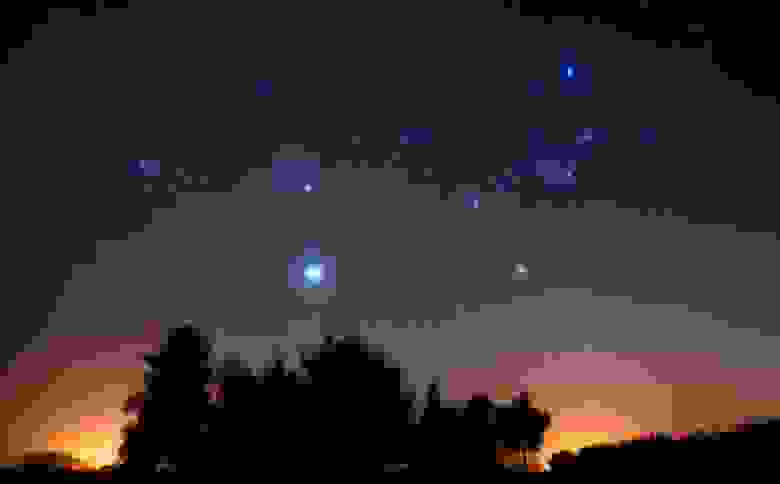
I have an insatiable appetite for acquiring new knowledge. The essence lies in the continuous process of learning and expanding one’s intellectual horizons day after day. This pursuit encapsulates the very essence of our existence in this world.
– Jay-Z
When one envisions the nocturnal expanse, the mind conjures up an image of countless stars glistening against the backdrop of a dark void, a spectacle that can only be truly appreciated in remote locations far removed from urban areas and other sources of light contamination.
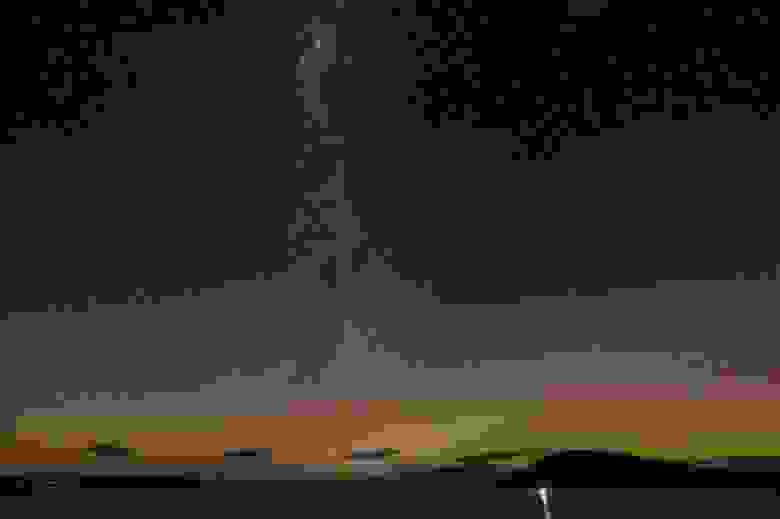
However, for those of us who do not have the opportunity to regularly witness such a spectacle, it is important to note that stars visible from urban areas with significant light pollution appear distinct from those observed in darker conditions. Their hue and relative luminosity set them apart from the surrounding stars, and each one carries its own unique narrative.
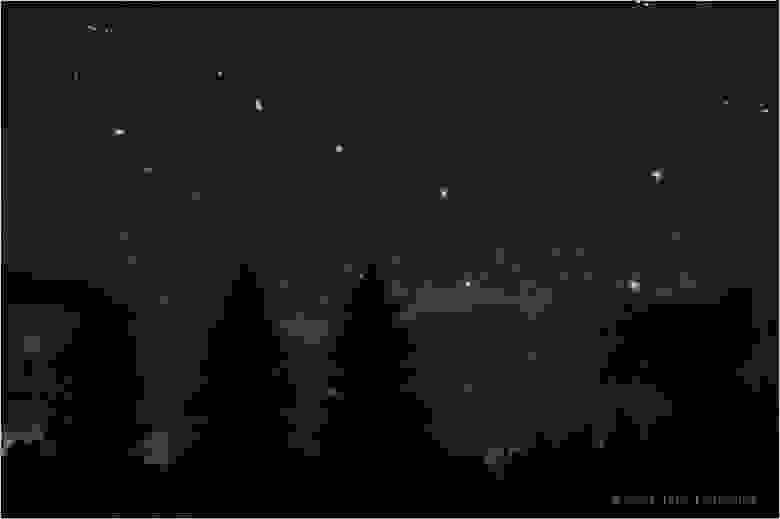
In the northern hemisphere, the Big Dipper or the letter W in Cassiopeia are easily identifiable, whereas in the southern hemisphere, the Southern Cross is the most well-known constellation. However, it should be noted that these stars are not among the top ten brightest.
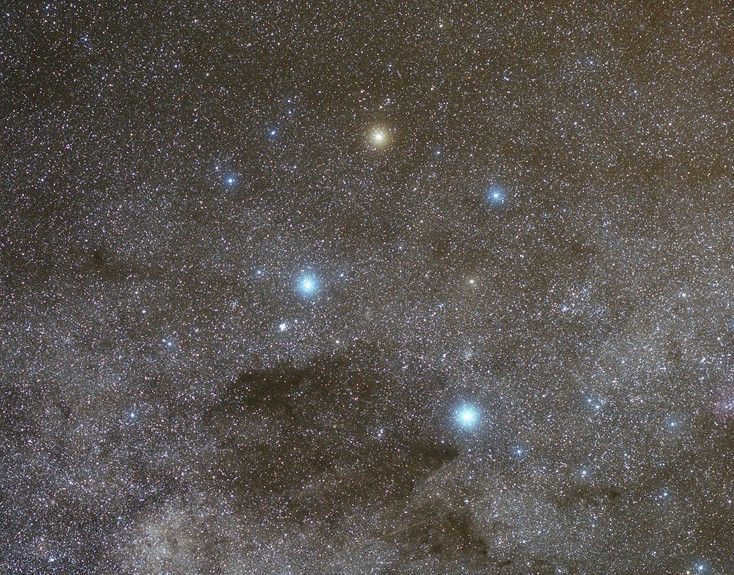
The Milky Way near the Southern Cross
Each star has its own life cycle, which it is bound to from the moment of its birth. The dominant element in the Universe when a star forms is hydrogen, which is the most abundant element. The fate of a star is determined solely by its mass. Stars with a mass 8% that of the sun have the ability to initiate a nuclear fusion reaction in their core, where they synthesize helium from hydrogen. As they do so, their energy gradually moves from the inside out and is released into the Universe. Low-mass stars have a red color due to their low temperatures, they are dim, and they burn their fuel slowly. The longest-lived low-mass stars have the potential to burn for trillions of years.
As a star accumulates more mass, its core becomes hotter and the area where nuclear fusion takes place expands. When a star reaches the size of the sun, it falls into the G category and has a lifespan of less than ten billion years. If the mass is doubled, the star becomes a class A star, shining brightly in a blue hue and living for less than two billion years. The most massive stars, classified as O and B, only live for a few million years before depleting their hydrogen fuel in the core. Unsurprisingly, these massive and hot stars are also the most luminous. A typical class A star can be twenty times brighter than the sun, while the most massive stars are tens of thousands of times brighter!
However, regardless of how a star begins its life, the hydrogen fuel in its core will eventually run out.
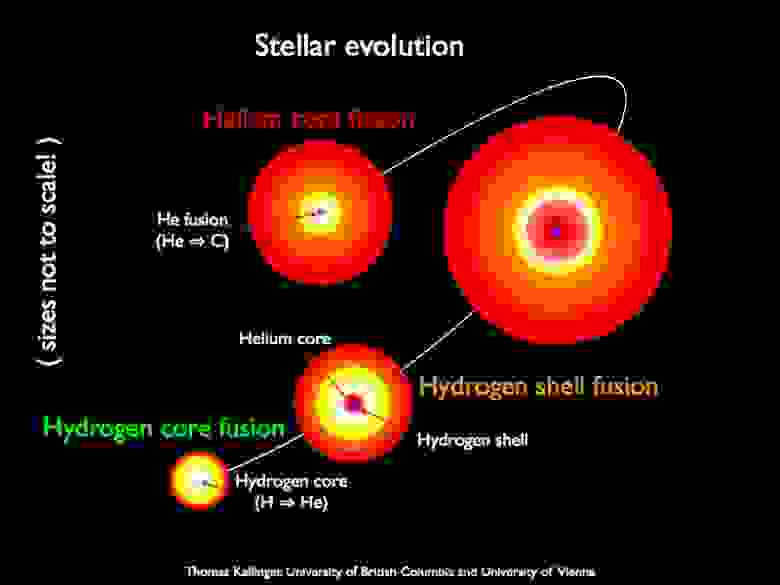
And from that moment, the star initiates the combustion of heavier elements, expanding into a massive star, which is cooler but also more luminous than the initial star. The massive phase is briefer than the hydrogen combustion phase, but its extraordinary luminosity enables it to be visible from significantly greater distances than the original star.
Considering all of this, let’s proceed to the ten most brilliant stars in our celestial sphere, listed in ascending order of luminosity.
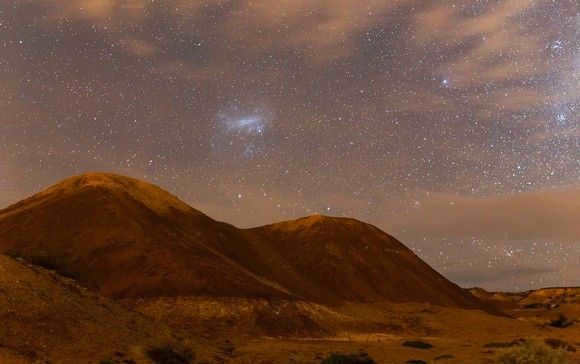
10. Ahernar. Ahernar is an extraordinary star that shines with a brilliant blue light. It is seven times more massive than our Sun and emits a stunning brightness that is 3000 times stronger. What makes Ahernar even more fascinating is its incredible speed of rotation. It spins so rapidly that its equatorial radius is 56% larger than its polar radius. As a result of this high-speed rotation, the temperature at its pole is 10,000 K higher than at its equator. Despite its incredible features, Ahernar is located quite far from us, approximately 139 light-years away.
Read also: How individuals attained wealth and prosperity
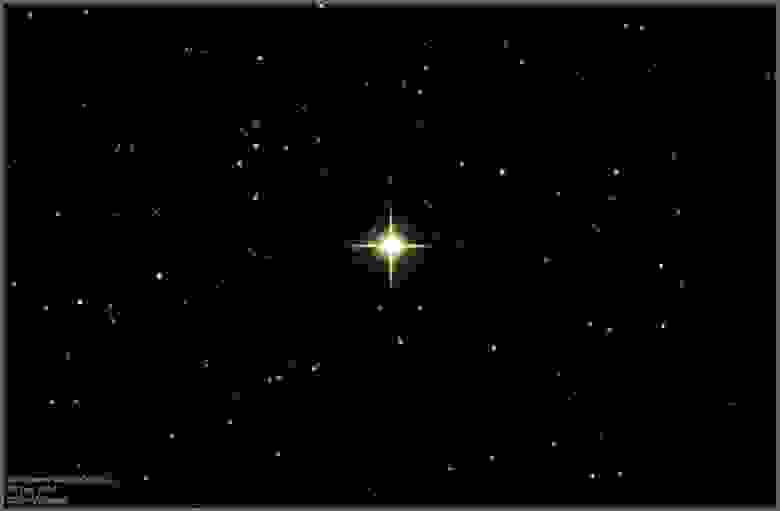
9. Betelgeuse. Betelgeuse is a red giant located in the Orion constellation. It used to be a bright and hot O-class star, but it eventually exhausted its hydrogen fuel and transitioned to helium. Despite its relatively low temperature of 3,500 K, Betelgeuse remains over 100,000 times brighter than the Sun. This is why it is considered one of the top ten brightest stars, despite being located 600 light-years away. In the next one million years, Betelgeuse is expected to undergo a supernova explosion, temporarily making it the brightest star in the sky. It may even be visible during daylight hours.
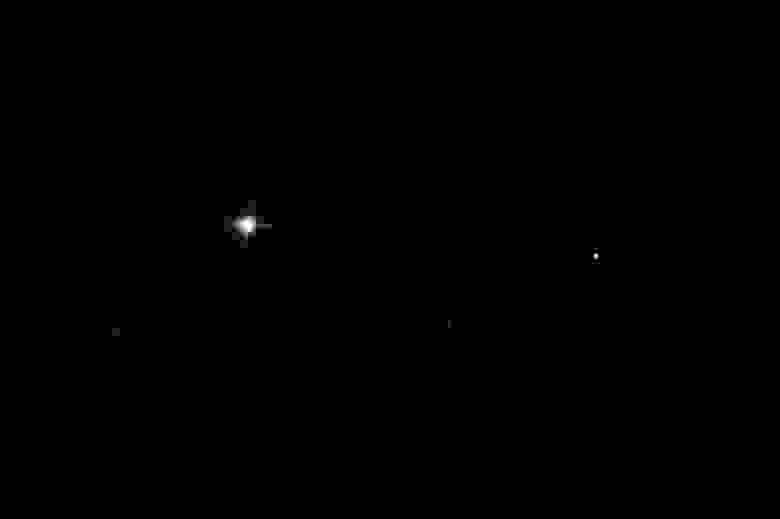
8. Procyon. This star differs significantly from the ones we have examined. Procyon is a humble F-class star, just 40% larger than the Sun, and is nearing the end of its hydrogen supply in its core – in other words, it is an evolving subgiant. It is roughly 7 times more luminous than the Sun, but it is only 11.5 light-years away, so it might be brighter than nearly all but seven stars in our celestial sphere.
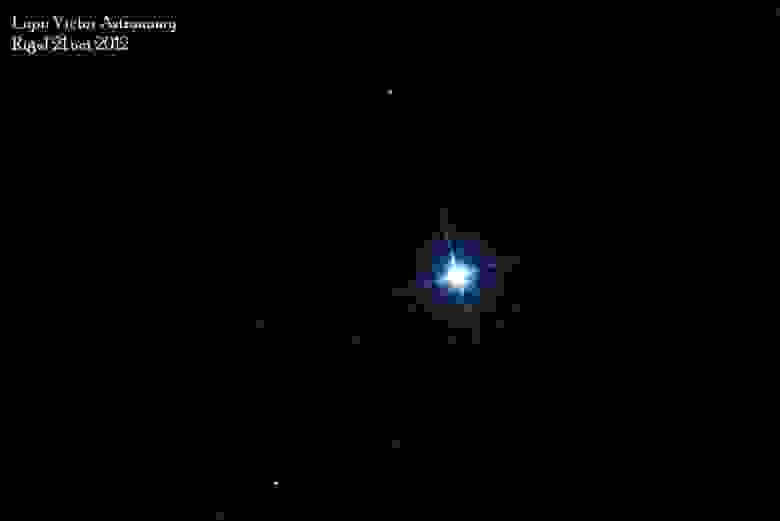
7. Rigel. Although Betelgeuse is not the most luminous star in the Orion constellation, the title goes to Rigel, a star located even further away. Rigel is situated at a distance of 860 light-years and has a temperature of only 12,000 degrees. Unlike a main-sequence star, Rigel is a rare blue supergiant. It outshines the Sun by a factor of 120,000, not due to its distance from us, but because of its intrinsic brightness.
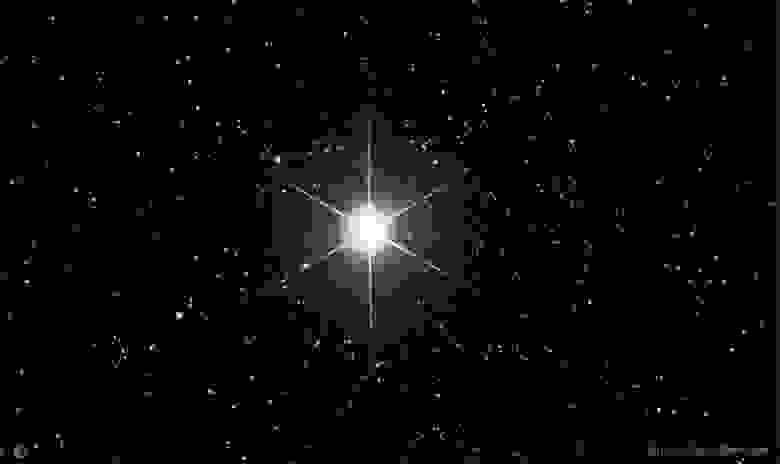
6. Capella. This star is peculiar because it consists of two red giants, each with temperatures similar to the Sun’s, yet both are approximately 78 times brighter than the Sun. Capella is included in our list due to its individual brightness, relatively close distance of 42 light years, and the unique factor of being a binary star system.
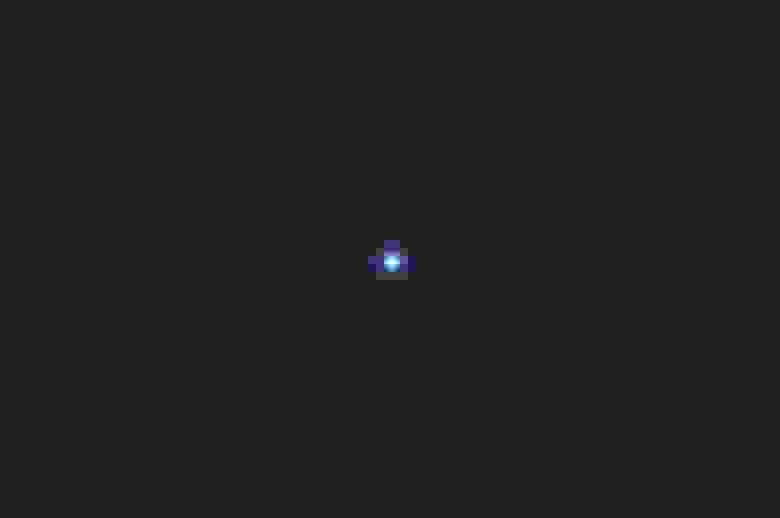
5. Vega. Vega is the most luminous star in the Summer-Fall Triangle and is famously known as the home of the extraterrestrial beings depicted in the movie Contact. Astronomers have designated Vega as a reference point for measuring the brightness of other stars, giving it a “zero magnitude” status. Located a mere 25 light-years away, Vega is classified as a main-sequence star and is among the brightest Class A stars in our knowledge. Remarkably, it is relatively young, with an age of only 400-500 million years. In addition, Vega shines with a brightness that is 40 times greater than that of the Sun, making it the fifth brightest star visible in the sky. Notably, among all the stars in the northern hemisphere, Vega is surpassed in brightness only by one other star…
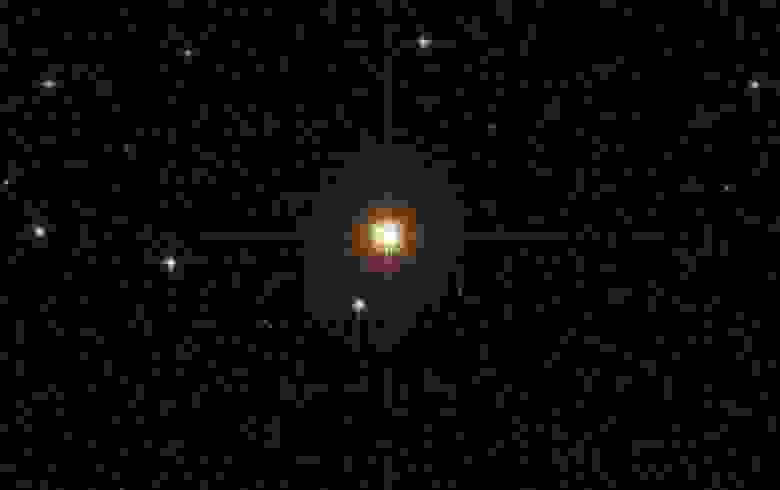
4. Arcturus. Arcturus, also known as the Orange Giant, falls somewhere between Procyon and Capella in terms of its evolutionary stage. It stands out as the brightest star in the northern hemisphere and can easily be spotted by following the “handle” of the Big Dipper. In fact, it is 170 times brighter than our Sun, and based on its evolutionary trajectory, it has the potential to become even more luminous! Arcturus is located a mere 37 light-years away, and only three stars, all situated in the southern hemisphere, outshine its brilliance.

3. Alpha Centauri. This is a triple star system in which the primary star is quite similar to the Sun, but is actually dimmer than any other star in the top ten. However, what sets the Alpha Centauri system apart is its proximity to Earth, as it is the closest star system to us, being only 4.4 light-years away. This close proximity greatly influences its apparent brightness, making it very different from the star ranked at #2 on the list.
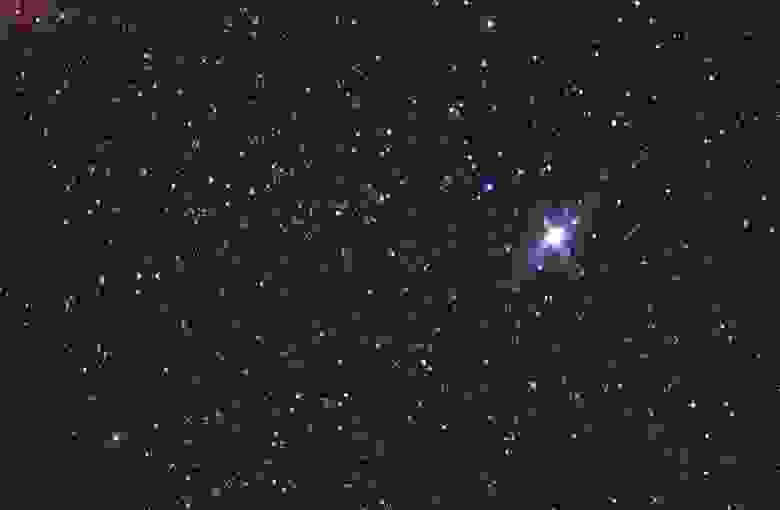
2. Canopus. Canopus is a supergiant star that shines with a white color. It is an impressive 15,000 times brighter than the Sun, making it the second-brightest star in the night sky. Despite its distance of 310 light-years away, Canopus still manages to stand out. Its mass is ten times greater than that of the Sun, and it is 71 times larger in size. With such incredible dimensions, it is no surprise that Canopus shines so brightly. However, it falls short of claiming the title of the brightest star in the sky. That honor goes to another star.
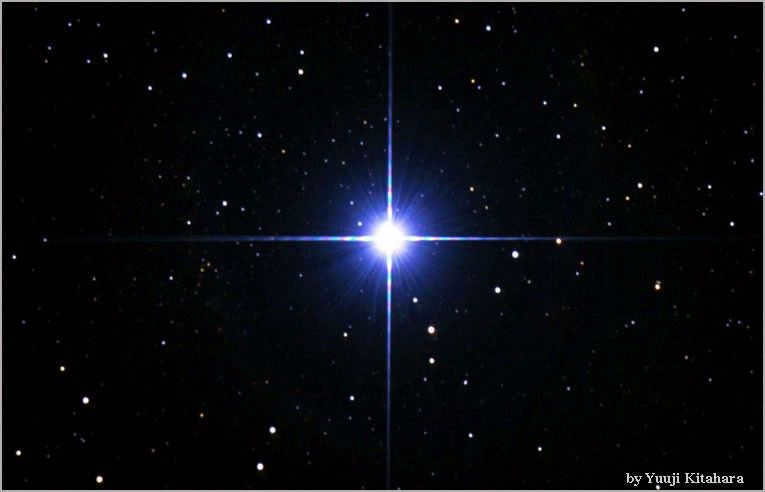
1. Sirius. It has a brightness level that is double that of Canopus, and observers in the northern hemisphere often have the opportunity to witness its rising behind the constellation Orion during the winter months. The reason for its frequent twinkling is that its intense light has the ability to penetrate the lower atmosphere more effectively than that of other stars. Despite being a mere 8.6 light-years away, Sirius is categorized as a Class A star and is twice as massive and 25 times brighter than the Sun.
It may come as a surprise that the initial stars mentioned in this list are not necessarily the brightest or closest ones, but rather a combination of being sufficiently bright and located at a favorable distance to appear the brightest. Stars that are twice as distant have a brightness level that is four times lower, meaning that Sirius shines brighter than Canopus, which in turn shines brighter than Alpha Centauri, and so on. Interestingly, the list does not include any M-class dwarf stars, which make up three quarters of all stars in the Universe.
There is an important lesson to be learned from this experience: sometimes the things that appear most prominent and obvious to us are actually quite unusual. It can be much more challenging to find the common things, which means that we must enhance our observational methods!
- Recent articles
- Installing art parquet by yourself
- The optimal method to protect your gas block walls from deterioration during the first winter after constructing your house
- Arbolite, also known as sawdust concrete
- Characteristics of sound insulation for rooms
- Clay with sawdust – the most effective and affordable way to insulate concrete walls of your house
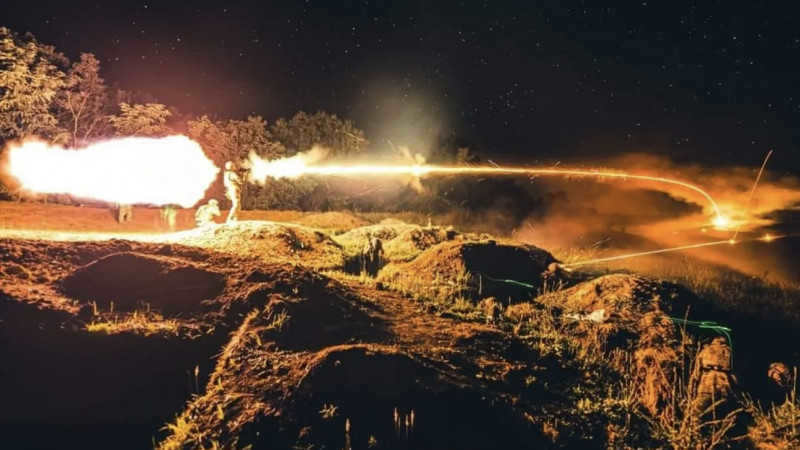
The primary events in Ukraine on the morning of August 18 are covered by Tengrinews.kz.
Ankara cautions Moscow about escalating tensions in the Black Sea
The Turkish authorities have issued a warning to the Russian side regarding incidents similar to the recent forced halt of the dry cargo ship “Shukryu Okan” by a vessel from the Black Sea Fleet on August 13. A statement from the Center for Combating Disinformation at the Communications Directorate of Turkish President Recep Erdogan’s administration emphasized that the Russian side has been duly cautioned against allowing such actions that increase tension in the Black Sea region.
📌 “The allegations that the Russian military attacked the Turkish ship Şükrü Okan and the Turkish government did not react” contain manipulation. pic.twitter.com/p2BzOgxdYP
– Dezenformasyonla Mücadele Merkezi (@dmmiletisim) August 17, 2023
However, the Dezenformasyonla Mücadele Merkezi (Disinformation Combat Center) has pointed out that these claims are misleading. They state that the incident involving the Şükrü Okan dry cargo ship actually took place in international waters, not Turkish internal waters. The ship, though owned by a Turkish company, was flying the flag of Palau, not Turkey. According to international law, the flag of the state the ship is registered under is more significant than the ship’s name or the nationality of its owner, the report explains.
A drone was brought down in Moscow
The mayor of Moscow, Sergei Sobyanin, announced on Friday night that Russian air defense forces had successfully taken down a drone that was attempting to fly over the city.
The debris from the unmanned aerial vehicle (UAV) fell in the vicinity of Expocentre, which is situated in the heart of the city. As a result, the airspace in the Vnukovo area has been temporarily closed, leading to the postponement of departures and arrivals.
Sobyanin reassured the public that the Expocenter building did not sustain any significant damage. In a message posted on his Telegram channel, he stated, “There are no reported casualties at this time. The city’s emergency services are currently on site and attending to the situation.”
Emergency services informed the TASS news agency that a portion of the outer wall of one of the pavilions at the Expo Center, located on Krasnopresnenskaya Embankment near Moscow City, had partially collapsed. The affected area is estimated to be around 30 square meters.
Russian Defense Ministry Claims: AFU’s Failed Attempt to Attack Black Sea Fleet Ships
The Russian Defense Ministry has announced that the Armed Forces of Ukraine (AFU) made an unsuccessful attempt to attack ships belonging to the Black Sea Fleet. The incident took place in the southwestern region of the Black Sea on Thursday evening and involved an uncrewed sea boat.
In a statement, the Russian military ministry stated, “The uncrewed boat of the enemy was neutralized by the Black Sea Fleet’s patrol ships, Pytlivy and Vasily Bykov, using their onboard weapons. The attack did not reach its intended target.”
Reports: US Approves Sending F-16s to Ukraine
According to media reports, the United States has given approval for the transfer of F-16 fighter jets to Ukraine. The aircraft will be coming from Denmark and the Netherlands, and the dispatch will take place after the completion of pilot training. An unnamed official from Washington confirmed this information to Reuters on August 18.
In a letter obtained by Reuters journalists, U.S. Secretary of State Anthony Blinken expressed full support for the transfer of F-16s to Ukraine, as well as the training of Ukrainian pilots by qualified F-16 instructors. He highlighted that this move will enable Ukraine to make use of its new capabilities once the first group of pilots completes their training.





